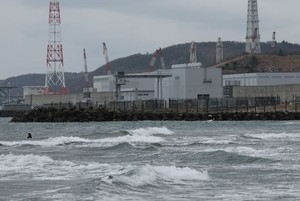September 24, 2021 at 15:40 JST
 Storage tanks hold contaminated water at the Fukushima No. 1 nuclear power plant on April 12. (Asahi Shimbun file photo)
Storage tanks hold contaminated water at the Fukushima No. 1 nuclear power plant on April 12. (Asahi Shimbun file photo)
Japan’s nuclear power policy has emerged as one of the main issues for the ruling Liberal Democratic Party’s leadership race.
The four candidates for the party presidential election on Sept. 29 should face up to the lessons from the disaster that unfolded at Tokyo Electric Power Co.’s Fukushima No. 1 nuclear power plant a decade ago and offer specific policy proposals for ensuring in-depth debate on key questions.
Taro Kono, the minister of administrative reform who also served as foreign and defense minister in the past, is the only one among the contenders who has clearly argued for phasing out nuclear power generation.
Kono has stated that Japan should pull the plug on its nuclear fuel recycling program “as soon as possible” while promising to allow offline reactors to be restarted when they are officially endorsed as safe, for the time being.
The other three politicians seeking to succeed outgoing Prime Minister Yoshihide Suga have committed themselves to maintaining the current policy of keeping nuclear reactors running. During a recent debate, they voiced skepticism about Kono’s vow to end the fuel recycling program.
Fumio Kishida, a former foreign minister and LDP policy chief, questioned the consistency between Kono’s position on fuel recycling and his policy of allowing reactors to be brought on stream.
Seiko Noda, executive acting secretary-general of the LDP, ruled out any energy policy change that could cause a disruption in the stable supply of power. Sanae Takaichi, a former communications minister, stressed she would promote the development of small reactors and nuclear fusion reactor technology.
The nuclear fuel recycling process involves recovering plutonium from spent nuclear fuel for recycling back into new fuel.
But Japan’s original plan to reprocess spent nuclear fuel to obtain start-up plutonium for a new generation of plutonium “fast breeder” reactors fell through when its Monju prototype fast breeder reactor, which was supposed to be the core technology for the program, was shut down after a sodium leak and fire.
The government then shifted to a strategy of converting spent plutonium, formed in nuclear reactors as a by-product of burning uranium fuel, and uranium into a “mixed oxide” (MOX) that can be reused in existing reactors to produce more electricity.
But this approach has also hit a snag as the number of operating reactors has declined sharply since the Fukushima meltdowns.
Asahi Shimbun editorials have argued that the government should concede that the fuel recycling program is no longer viable and declare an end to it. To be sure, withdrawing from the program would mean spent nuclear fuel must be disposed of as waste. But Japan would only make the world uneasy if it keeps a massive stockpile of weapons-usable plutonium without any plan to use it.
Arguments concerning nuclear policy issues in general, not just fuel recycling, tend to overlook reality. The most important fact about the catastrophic accident at the Fukushima plant is that it caused tremendous damage to society.
Not much is known about the current conditions of the reactors whose cores melted down during the accident. There is no predicting when and how the process of decommissioning the plant will come to an end.
The LDP presidential candidates are divided over whether to build new nuclear plants or expand current ones. But it is obvious that winning the support of the public in general and the local communities involved for such plans would be next to impossible.
It is also unclear when the small reactor and the nuclear fusion reactor that are under development will enter commercial use.
A new estimate by the industry ministry on the future costs of power generation published in August predicts that solar power will eclipse nuclear energy in terms of costs as of 2030. It is hardly surprising that the government’s draft new Basic Energy Plan, unveiled in July, says promoting renewable energy sources should be the top energy policy priority.
Since the Fukushima disaster, the government has been seeking to restart offline reactors one by one while leaving the decisions up to the Nuclear Regulation Authority. But the government should not shy away from a sweeping review of its broken nuclear energy policy.
There are many sticky questions the LDP presidential hopefuls need to address. How would they try to change the country’s current energy mix in what ways and in what kind of time frames while maintaining a steady power supply? What would they do with the growing amount of spent nuclear fuel?
The LDP election requires them to clarify their approaches to tackling these tough challenges.
--The Asahi Shimbun, Sept. 24




















A peek through the music industry’s curtain at the producers who harnessed social media to help their idols go global.
A series based on diplomatic documents declassified by Japan’s Foreign Ministry
Here is a collection of first-hand accounts by “hibakusha” atomic bomb survivors.
Cooking experts, chefs and others involved in the field of food introduce their special recipes intertwined with their paths in life.
A series about Japanese-Americans and their memories of World War II